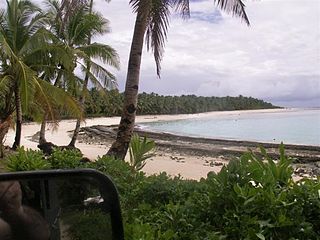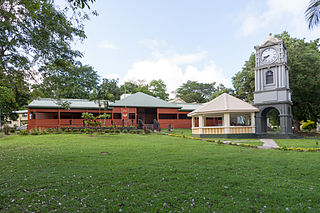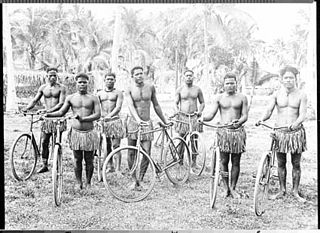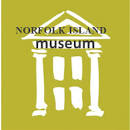Related Research Articles

Melanesia is a subregion of Oceania in the southwestern Pacific Ocean. It extends from New Guinea in the west to the Fiji Islands in the east, and includes the Arafura Sea.

German New Guinea consisted of the northeastern part of the island of New Guinea and several nearby island groups and was the first part of the German colonial empire. The mainland part of the territory, called Kaiser-Wilhelmsland, became a German protectorate in 1884. Other island groups were added subsequently. The Bismarck Archipelago, and the North Solomon Islands were declared a German protectorate in 1885. The Caroline Islands, Palau, and the Mariana Islands were bought from Spain in 1899. German New Guinea annexed the formerly separate German Protectorate of Marshall Islands, which also included Nauru, in 1906. German Samoa, though part of the German colonial empire, was not part of German New Guinea.
Tupaia was a Tahitian Polynesian navigator and arioi, originally from the island of Ra'iatea in the Pacific Islands group known to Europeans as the Society Islands. His remarkable navigational skills and Pacific geographical knowledge were to be utilised by Lt. James Cook, R.N. when he took him aboard HMS Endeavour as guide on its voyage of exploration to Terra Australis Incognita. Tupaia travelled with Cook to New Zealand, acting as the expedition's interpreter to the Polynesian Māori, and Australia. He died in December 1770 from a shipborne illness contracted when Endeavour was docked in Batavia for repairs ahead of its return journey to England.
Jorge de Menezes was a Portuguese explorer. Due to a monsoon, he was forced to reside in Versya, posited by Pieter Anton Tiele as Waisai, between 1526 and 1527. Menezes called the region Ilhas dos Papuas, though the name of "Papua" was already known at the time. Yet he was still the first European to go ashore and thus credited with the European discovery of New Guinea.
William Leonard Gammage is an Australian academic historian, adjunct professor and senior research fellow at the Humanities Research Centre of the Australian National University (ANU). Gammage was born in Orange, New South Wales, went to Wagga Wagga High School and then to ANU. He was on the faculty of the University of Papua New Guinea and the University of Adelaide. He is a fellow of the Australian Academy of Social Sciences and deputy chair of the National Museum of Australia.

Motusa is a group of close villages in the district of Itu'tiu, on the island of Rotuma, one of the islands of Fiji. Rotuma is made up of two volcanic landmasses connected by a sandy isthmus, on which Motusa is located. For this reason it has one of the islands longest white sandy beach. Motusa also sits between the Islands two largest bay; Maka Bay to the North and Hapmafau Bay to the South.
Jack Finsterer is an Australian film and TV actor. He has been acting since the age of 25 and has appeared in some of Australia's best-known TV shows. He is also a film actor who has participated in 43 Television Series and Films from 1993 to 2022.

Dame Alice Wedega, DBE was a Papuan politician, educator, peacemaker and conscientious objector.

The Fiji Museum is a museum in Suva, Fiji located in the capital city's botanical gardens, Thurston Gardens.
The Festival of Pacific Arts and Culture, Pacific Arts Festival, or FestPAC is a traveling festival hosted every four years, in the same year as the Summer Olympics, by a different country in Oceania (map). It was conceived by the Pacific Community as a means to stem erosion of traditional cultural practices by sharing and exchanging culture at each festival. The major theme of the festival is traditional song and dance. The 2008 Festival of Pacific Arts was hosted by American Samoa from 20 July to 2 August 2008; it was the 10th Festival of Pacific Arts.

The Kingdom of Fiji, also known as the Kingdom of Viti, was a short-lived monarchy in Fiji. It existed from 1871 to 1874, with Ratu Seru Epenisa Cakobau as King.

Charles Eaton was a barque, launched in 1833 for use as a merchant ship. Whilst under the command of Captain Fowle, she was wrecked in 1834 among the Torres Strait Islands, off the northern coast of Queensland, Australia, and her passengers and crew attacked and nearly all killed by Torres Strait Islanders on Mer Island. A cabin boy and small child survived and lived with the islanders until being rescued by Captain Lewis and crew on Isabella in June 1836, who also found skulls of some of the murdered people on a nearby island and took them back to Sydney for burial.

John William Lindt (1845–1926), was a German-born Australian landscape and ethnographic photographer, early photojournalist, and portraitist.

Thomas John McMahon FRGS was an Australian photojournalist and writer. From 1915 to 1922 he made several trips to Melanesia and Micronesia.
Alexandra Szalay is an Australian anthropologist and mammalogist, who specialises in the study of Papua New Guinea. The Gebe cuscus is named after her.
Marshallese nationality law is regulated by the Marshallese Constitution of 1979, as amended; the 1984 Citizenship Act of the Marshall Islands, and its revisions; and international agreements entered into by the Marshallese government. These laws determine who is, or is eligible to be, a national of the Marshall Islands. The legal means to acquire nationality, formal membership in a nation, differ from the domestic relationship of rights and obligations between a national and the nation, known as citizenship. Marshallese nationality is typically obtained either on the principle of jus soli, i.e. by birth in the Marshall Islands or under the rules of jus sanguinis, i.e. by birth abroad to parents with Marshallese nationality. It can be granted to persons with an affiliation to the country, or to a permanent resident who has lived in the country for a given period of time through naturalization.
Papua New Guinean nationality law is regulated by the 1975 Constitution of Papua New Guinea, as amended; the Citizenship Act 1975, and its revisions; and international agreements entered into by the Papua New Guinean government. These laws determine who is, or is eligible to be, a national of Papua New Guinea. The legal means to acquire nationality, formal legal membership in a nation, differ from the domestic relationship of rights and obligations between a national and the nation, known as citizenship. Papua New Guinean nationality is typically obtained either on the principle of jus soli, i.e. by birth in Papua New Guinea or under the rules of jus sanguinis, i.e. by birth abroad to parents with Papua New Guinean nationality. It can be granted to persons who have lived in the country for a specific period of time, who have contributed to the country's development, or who have an affiliation to the country through naturalization.
Solomon Islands nationality law is regulated by the 1978 Constitution of Solomon Islands, as amended; the Citizenship Act 2018, and its revisions; and international agreements entered into by the government of Solomon Islands. These laws determine who is, or is eligible to be, a national of Solomon Islands. The legal means to acquire nationality, formal legal membership in a nation, differ from the domestic relationship of rights and obligations between a national and the nation, known as citizenship. Solomon Islander nationality is typically obtained either on the principle of jus soli, i.e. by birth in the Solomon Islands or under the rules of jus sanguinis, i.e. by birth abroad to parents with Solomon Islander nationality. It can be granted to persons who have lived in the country for a specific period of time, or who have an affiliation to the country through naturalisation.
Under Three Flags: Anarchism and the Anti-Colonial Imagination is a 2006 book by Benedict Anderson on the intersection of Philippine nationalism and late 19th century anarchism.

Norfolk Island Museum is a museum organisation on Norfolk Island, an external territory of Australia in the southern Pacific Ocean. The museum comprises five sites and collections that include archaeological, archival and social history objects that reflect subsequent waves of forced migration to the island.
References
- ↑ Quanchi, Max; Robson, John (2009). Historical dictionary of the discovery and exploration of the Pacific islands. Lanham, MD: Scarecrow Press. ISBN 978-0-8108-6528-0. OCLC 731152107.
- ↑ Quanchi, Max (1996). Photography, representation and cross-cultural encounters: seeking reality in Papua 1880-1930 (Thesis). OCLC 639288615.
- 1 2 Kahn, Miriam (2018-03-28). "Postcards from Oceania: Port Towns, Portraits and the Picturesque during the Colonial Era | By Max Quanchi, Max Shekleton". Pacific Affairs (UBC Journal). Retrieved 2022-06-19.
- 1 2 Mayer, Carol E. (2011). ""Photographing Papua: representation, colonial encounters and imaging in the public domain" by Max Quanchi (review)". The Journal of Pacific History. 46 (1): 139–140. doi:10.1080/00223344.2011.573647. S2CID 161526396.
- ↑ Johnston, Anna; Rolls, Mitchell (2019). Travelling home: 'Walkabout magazine' and mid-twentieth-century Australia. Anthem Press. pp. 7, 180, 184, 185. ISBN 978-1-78527-190-8. OCLC 1112384166.
- ↑ Quanchi, Max (2010). 'It's Our Turn to Give Orders'. Walkabout's View of a Nation in the Making. University of Papua New Guinea. pp. 110–116. OCLC 1160110126.
- ↑ Quanchi, Max; So'o, Asofou; Council of Presidents of Pacific Island History Associations (2003). Teaching history: a guide for teachers teaching history for the first time. Brisbane: Council of Presidents of Pacific Island History Associations. OCLC 225921975.
- ↑ "Rudd meets with Solomon Islands leader". ABC Radio National. 2008-01-25. Retrieved 2022-06-19.
- ↑ "The Sea". Radio National. 2002-10-16. Retrieved 2022-06-19.
- ↑ "In The Wake of The Caledonia". Radio National. 2004-05-06. Retrieved 2022-06-19.
- ↑ McCall, Grant Edwin (2000). "Niu History" (Catalogue record). doi: 10.26190/unsworks/464 . hdl: 1959.4/39469 .
- ↑ "National Museum of Australia: Appendix 6: Conferences, forums, seminars and lectures hosted by the National Museum of Australia 2007/2008, pp. no. 491 of 2008". Trove. 2008. Retrieved 2022-06-19.
- ↑ Quanchi, Max (1 March 1982). "Letters: Pacific-Caribbean ties stronger". Pacific Islands Monthly. 53 (3): 11.
- ↑ Quanchi, Max (1 November 1999). "In a savage land review". Pacific Islands Monthly. 69 (11): 57–58.
- ↑ Quanchi, Max (1 November 1980). "Australian dreams of Island empire - review of Australian Imperialism in the Pacific, By Roger C. Thompson. Melbourne University Press. ISBN 0 522 84207 0". Pacific Islands Monthly. 51 (11): 43–44.
- ↑ Max Quanchi. Review of "The Echo of Things: The Lives of Photographs in the Solomon Islands" by Christopher Wright. caa.reviews. August 2014. doi:10.3202/caa.reviews.2014.96
- ↑ Cruickshank, Joanna; Veracini, Lorenzo; Standfield, Rachel; Karskens, Grace; Martin, Susan K.; Eklund, Erik; Grosvenor, Ian; McKenna, Mark; Ginn, Geoff; Llewellyn, David; Jeppesen, Jennie (2011-09-01). "Books". Australian Historical Studies. 42 (3): 425–441. doi:10.1080/1031461X.2011.595899. ISSN 1031-461X. S2CID 218623986.
- 1 2 Leckie, Jacqueline (2021). ""An Ideal Colony and Epitome of Progress: Colonial Fiji in Picture Postcards." (review)". Journal of Pacific History. 56 (2): 212–13. doi:10.1080/00223344.2021.1893627. S2CID 233690422.
- ↑ Amaama, Safua Akeli. Review of Postcards from Oceania: Port Towns, Portraits and the Picturesque during the Colonial Era, by Max Quanchi and Max Shekleton. The Contemporary Pacific, vol. 30 no. 2, 2018, p. 557-559. Project MUSE, doi:10.1353/cp.2018.0046.
- ↑ Kahn, Miriam (June 2017). "Review: Postcards From Oceania: Port Towns, Portraits and the Picturesque during the Colonial Era". Pacific Affairs. The University of British Columbia. 90 (2): 423–5.
- ↑ ""The A to Z of the discovery and exploration of the Pacific islands. (reprint, 2005)." , vol. 25, no. 1". Reference & Research Book News. 25 (1). February 2010.
- ↑ Hasselberg, Jan (2018). "The Visual Inheritance: Collections of Historical Photographs from Papua New Guinea". The Journal of Pacific History. 53 (3): 287–309. doi:10.1080/00223344.2018.1471781. S2CID 165250627.
- ↑ Hughes, H.G.A. (2014). "Review: Historical Dictionary of the Discovery and Exploration of the Pacific Islands Max Quanchi and John Robson". Reference Reviews. 20: 58–59.
- ↑ Juvik, James O.; Juvik, Sonia P. (2006). "Review of Atlas of the Pacific Islands, by Max Quanchi". The Contemporary Pacific . 18 (1): 196–97. hdl:10125/13934. ISSN 1043-898X.
- ↑ Werner, Edward K. (15 April 2003). "Quanchi, Max. Atlas of the Pacific Islands". Library Journal. 128 (7): 74.
- ↑ Review of Refined White, Queensland Museum, Brisbane, regional and interstate 2001-2002; and Embarquement pour le Queensland; Des Loyaltiens en terre australienne (Across the Coral sea: Loyalty islanders in Queensland) Bibliothque Bernheim, Noumea a. Carfax. 2002. doi:10.1080/00223340220139324. OCLC 828750278. S2CID 219618435.